英文修辞手法介绍
- 格式:doc
- 大小:34.50 KB
- 文档页数:4
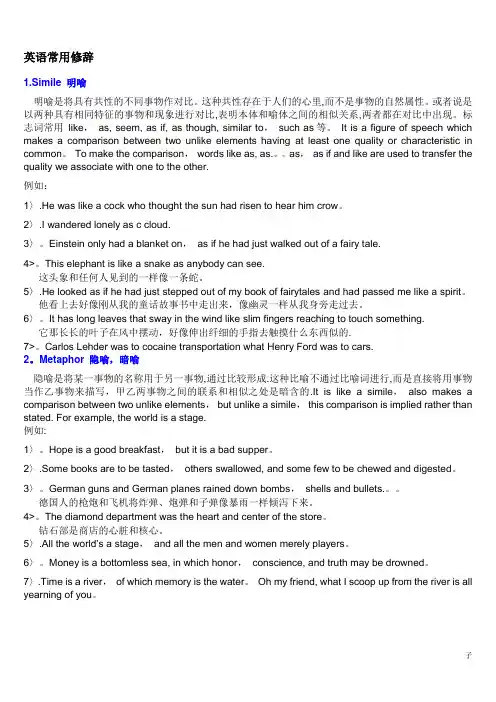
英语常用修辞1.Simile 明喻明喻是将具有共性的不同事物作对比。
这种共性存在于人们的心里,而不是事物的自然属性。
或者说是以两种具有相同特征的事物和现象进行对比,表明本体和喻体之间的相似关系,两者都在对比中出现。
标志词常用like,as, seem, as if, as though, similar to,such as等。
It is a figure of speech which makes a comparison between two unlike elements having at least one quality or characteristic in common。
To make the comparison,words like as, as.。
as,as if and like are used to transfer the quality we associate with one to the other.例如:1〉.He was like a cock who thought the sun had risen to hear him crow。
2〉.I wandered lonely as c cloud.3〉。
Einstein only had a blanket on,as if he had just walked out of a fairy tale.4>。
This elephant is like a snake as anybody can see.这头象和任何人见到的一样像一条蛇。
5〉.He looked as if he had just stepped out of my book of fairytales and had passed me like a spirit。
他看上去好像刚从我的童话故事书中走出来,像幽灵一样从我身旁走过去。
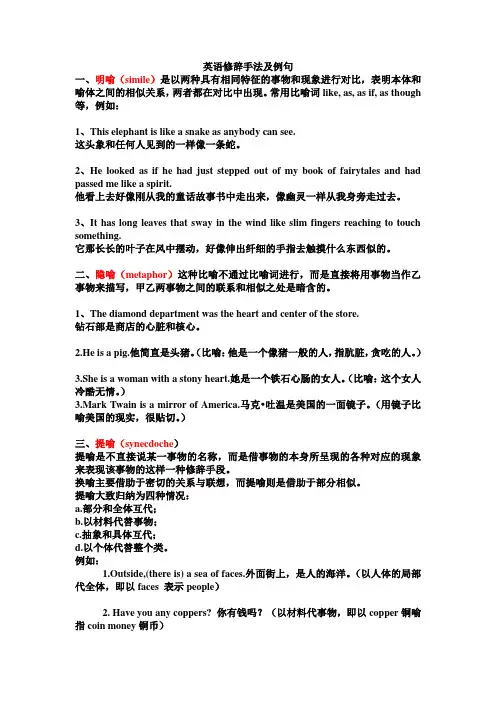
英语修辞手法及例句一、明喻(simile)是以两种具有相同特征的事物和现象进行对比,表明本体和喻体之间的相似关系,两者都在对比中出现。
常用比喻词like, as, as if, as though 等,例如:1、This elephant is like a snake as anybody can see.这头象和任何人见到的一样像一条蛇。
2、He looked as if he had just stepped out of my book of fairytales and had passed me like a spirit.他看上去好像刚从我的童话故事书中走出来,像幽灵一样从我身旁走过去。
3、It has long leaves that sway in the wind like slim fingers reaching to touch something.它那长长的叶子在风中摆动,好像伸出纤细的手指去触摸什么东西似的。
二、隐喻(metaphor)这种比喻不通过比喻词进行,而是直接将用事物当作乙事物来描写,甲乙两事物之间的联系和相似之处是暗含的。
1、The diamond department was the heart and center of the store.钻石部是商店的心脏和核心。
2.He is a pig.他简直是头猪。
(比喻:他是一个像猪一般的人,指肮脏,贪吃的人。
)3.She is a woman with a stony heart.她是一个铁石心肠的女人。
(比喻:这个女人冷酷无情。
)3.Mark Twain is a mirror of America.马克•吐温是美国的一面镜子。
(用镜子比喻美国的现实,很贴切。
)三、提喻(synecdoche)提喻是不直接说某一事物的名称,而是借事物的本身所呈现的各种对应的现象来表现该事物的这样一种修辞手段。
换喻主要借助于密切的关系与联想,而提喻则是借助于部分相似。

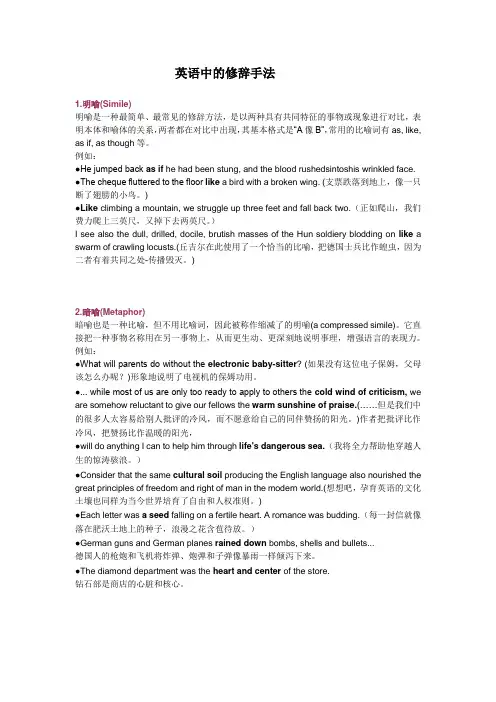
英语中的修辞手法1.明喻(Simile)明喻是一种最简单、最常见的修辞方法,是以两种具有共同特征的事物或现象进行对比,表明本体和喻体的关系,两者都在对比中出现,其基本格式是“A像B”,常用的比喻词有as, like, as if, as though等。
例如:●He jumped back as if he had been stung, and the blood rushedsintoshis wrinkled face.●The cheque fluttered to the floor like a bird with a broken wing. (支票跌落到地上,像一只断了翅膀的小鸟。
)●Like climbing a mountain, we struggle up three feet and fall back two.(正如爬山,我们费力爬上三英尺,又掉下去两英尺。
)I see also the dull, drilled, docile, brutish masses of the Hun soldiery blodding on like a swarm of crawling locusts.(丘吉尔在此使用了一个恰当的比喻,把德国士兵比作蝗虫,因为二者有着共同之处-传播毁灭。
)2.暗喻(Metaphor)暗喻也是一种比喻,但不用比喻词,因此被称作缩减了的明喻(a compressed simile)。
它直接把一种事物名称用在另一事物上,从而更生动、更深刻地说明事理,增强语言的表现力。
例如:●What will parents do without the electronic baby-sitter? (如果没有这位电子保姆,父母该怎么办呢?)形象地说明了电视机的保姆功用。
●... while most of us are only too ready to apply to others the cold wind of criticism, we are somehow reluctant to give our fellows the warm sunshine of praise.(……但是我们中的很多人太容易给别人批评的冷风,而不愿意给自己的同伴赞扬的阳光。
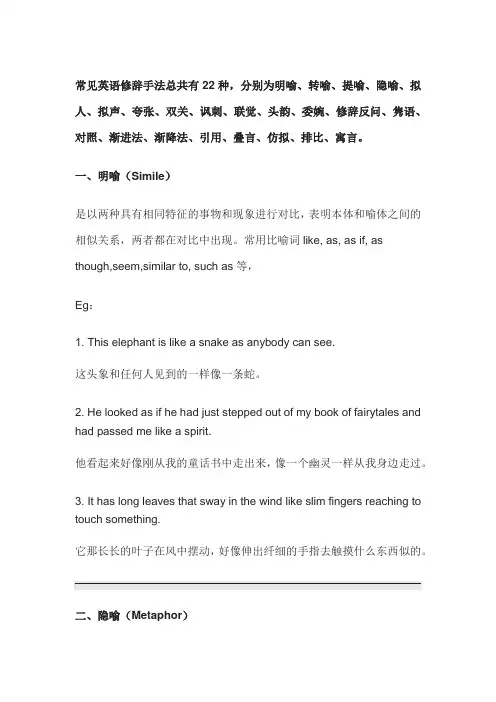
常见英语修辞手法总共有22种,分别为明喻、转喻、提喻、隐喻、拟人、拟声、夸张、双关、讽刺、联觉、头韵、委婉、修辞反问、隽语、对照、渐进法、渐降法、引用、叠言、仿拟、排比、寓言。
一、明喻(Simile)是以两种具有相同特征的事物和现象进行对比,表明本体和喻体之间的相似关系,两者都在对比中出现。
常用比喻词like, as, as if, as though,seem,similar to, such as等,Eg:1. This elephant is like a snake as anybody can see.这头象和任何人见到的一样像一条蛇。
2. He looked as if he had just stepped out of my book of fairytales and had passed me like a spirit.他看起来好像刚从我的童话书中走出来,像一个幽灵一样从我身边走过。
3. It has long leaves that sway in the wind like slim fingers reaching to touch something.它那长长的叶子在风中摆动,好像伸出纤细的手指去触摸什么东西似的。
二、隐喻(Metaphor)这种比喻不通过比喻词进行,而是直接将用事物当作乙事物来描写,甲乙两事物之间的联系和相似之处是暗含的。
Eg:1、The diamond department was the heart and center of the store. 钻石部是商店的心脏和核心。
2. He is a pig.他简直是头猪。
(比喻:他是一个像猪一般的人,指肮脏,贪吃的人。
)3. She is a woman with a stony heart.她是一个铁石心肠的女人。
(比喻:这个女人冷酷无情。
)4.Mark Twain is a mirror of America.马克吐温是美国的一面镜子。
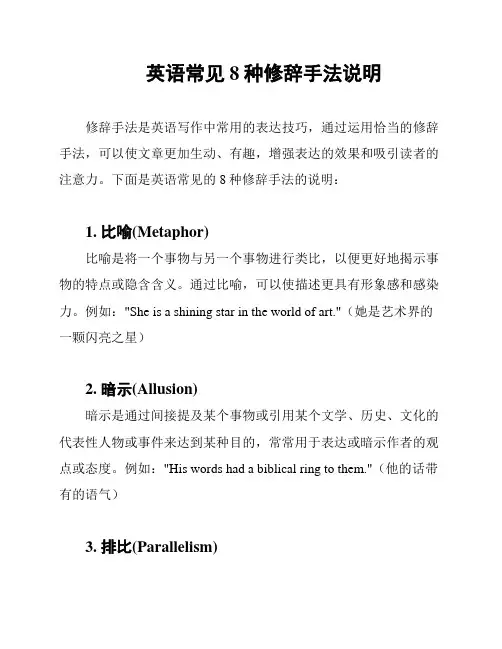
英语常见8种修辞手法说明修辞手法是英语写作中常用的表达技巧,通过运用恰当的修辞手法,可以使文章更加生动、有趣,增强表达的效果和吸引读者的注意力。
下面是英语常见的8种修辞手法的说明:1. 比喻(Metaphor)比喻是将一个事物与另一个事物进行类比,以便更好地揭示事物的特点或隐含含义。
通过比喻,可以使描述更具有形象感和感染力。
例如:"She is a shining star in the world of art."(她是艺术界的一颗闪亮之星)2. 暗示(Allusion)暗示是通过间接提及某个事物或引用某个文学、历史、文化的代表性人物或事件来达到某种目的,常常用于表达或暗示作者的观点或态度。
例如:"His words had a biblical ring to them."(他的话带有的语气)3. 排比(Parallelism)排比是通过重复使用类似的词、短语或句子结构,使文章的句子齐整有序,增强表达的力度和冲击力。
例如:"We came, we saw, we conquered." (我们来了,我们看到了,我们战胜了)4. 反问(Rhetorical Question)反问是在文章或演讲中提出一个问题,但并不期待对方回答,而是用问句来引导读者或听众思考某个问题或强调某个观点。
例如:"Isn't it a beautiful day?"(今天是不是个美好的一天呢?)5. 夸张(Hyperbole)夸张是通过夸大的描述方式来强调某个事物或情感,以达到增强效果的目的。
夸张常用于幽默、夸张或强调的场合。
例如:"I've told you a million times."(我已经告诉过你一百万次了)比较是通过将两个或多个事物进行对比,以突出它们的差异或相似之处,使表达更具有说服力和可信度。
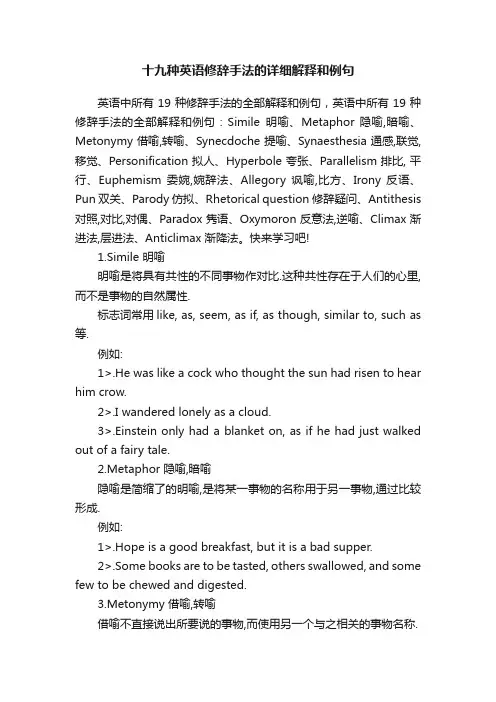
十九种英语修辞手法的详细解释和例句英语中所有19种修辞手法的全部解释和例句,英语中所有19种修辞手法的全部解释和例句:Simile明喻、Metaphor 隐喻,暗喻、Metonymy 借喻,转喻、Synecdoche 提喻、Synaesthesia 通感,联觉,移觉、Personification 拟人、Hyperbole 夸张、Parallelism 排比, 平行、Euphemism 委婉,婉辞法、Allegory 讽喻,比方、Irony 反语、Pun 双关、Parody 仿拟、Rhetorical question 修辞疑问、Antithesis 对照,对比,对偶、Paradox 隽语、Oxymoron 反意法,逆喻、Climax 渐进法,层进法、Anticlimax 渐降法。
快来学习吧!1.Simile 明喻明喻是将具有共性的不同事物作对比.这种共性存在于人们的心里,而不是事物的自然属性.标志词常用like, as, seem, as if, as though, similar to, such as 等.例如:1>.He was like a cock who thought the sun had risen to hear him crow.2>.I wandered lonely as a cloud.3>.Einstein only had a blanket on, as if he had just walked out of a fairy tale.2.Metaphor 隐喻,暗喻隐喻是简缩了的明喻,是将某一事物的名称用于另一事物,通过比较形成.例如:1>.Hope is a good breakfast, but it is a bad supper.2>.Some books are to be tasted, others swallowed, and some few to be chewed and digested.3.Metonymy 借喻,转喻借喻不直接说出所要说的事物,而使用另一个与之相关的事物名称.I.以容器代替内容,例如:1>.The kettle boils. 水开了.2>.The room sat silent. 全屋人安静地坐着.II.以资料.工具代替事物的名称,例如:Lend me your ears, please. 请听我说.III.以作者代替作品,例如:a complete Shakespeare 莎士比亚全集VI.以具体事物代替抽象概念,例如:I had the muscle, and they made money out of it. 我有力气,他们就用我的力气赚钱.4.Synecdoche 提喻提喻用部分代替全体,或用全体代替部分,或特殊代替一般.例如:1>.There are about 100 hands working in his factory.(部分代整体)他的厂里约有100名工人.2>.He is the Newton of this century.(特殊代一般)他是本世纪的牛顿.3>.The fox goes very well with your cap.(整体代部分)这狐皮围脖与你的帽子很相配.5.Synaesthesia 通感,联觉,移觉这种修辞法是以视.听.触.嗅.味等感觉直接描写事物.通感就是把不同感官的感觉沟通起来,借联想引起感觉转移,“以感觉写感觉”。
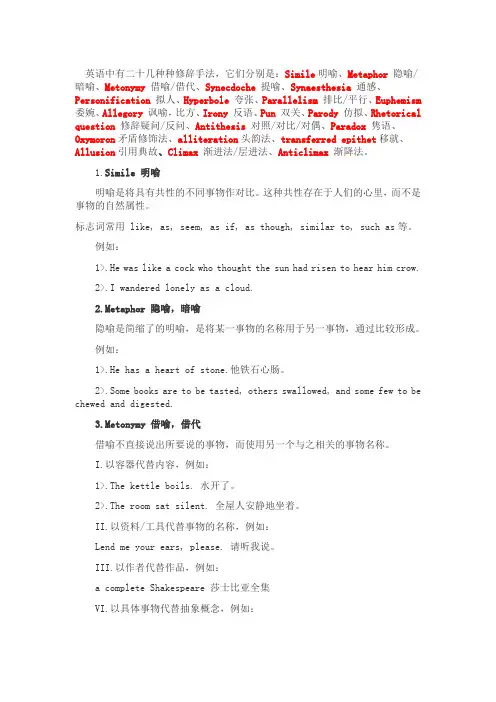
英语中有二十几种种修辞手法,它们分别是:Simile明喻、Metaphor隐喻/暗喻、Metonymy借喻/借代、Synecdoche提喻、Synaesthesia 通感、Personification拟人、Hyperbole夸张、Parallelism排比/平行、Euphemism 委婉、Allegory 讽喻,比方、Irony反语、Pun双关、Parody仿拟、Rhetorical question修辞疑问/反问、Antithesis对照/对比/对偶、Paradox隽语、Oxymoron矛盾修饰法、alliteration头韵法、transferred epithet移就、Allusion引用典故、Climax渐进法/层进法、Anticlimax渐降法。
1.Simile 明喻明喻是将具有共性的不同事物作对比。
这种共性存在于人们的心里,而不是事物的自然属性。
标志词常用 like, as, seem, as if, as though, similar to, such as等。
例如:1>.He was like a cock who thought the sun had risen to hear him crow.2>.I wandered lonely as a cloud.2.Metaphor 隐喻,暗喻隐喻是简缩了的明喻,是将某一事物的名称用于另一事物,通过比较形成。
例如:1>.He has a heart of stone.他铁石心肠。
2>.Some books are to be tasted, others swallowed, and some few to be chewed and digested.3.Metonymy 借喻,借代借喻不直接说出所要说的事物,而使用另一个与之相关的事物名称。
I.以容器代替内容,例如:1>.The kettle boils. 水开了。
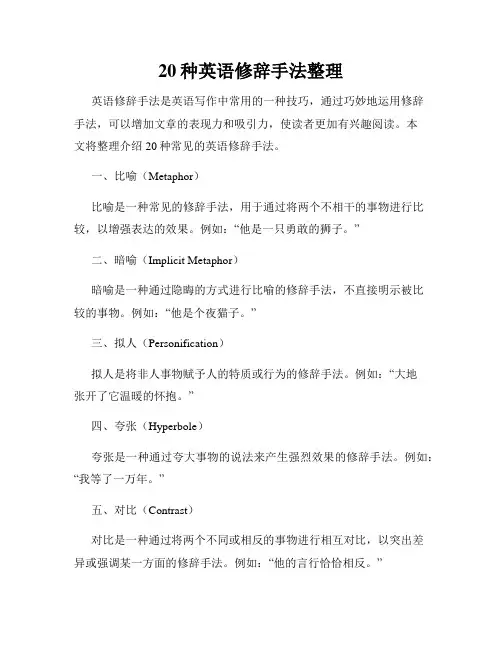
20种英语修辞手法整理英语修辞手法是英语写作中常用的一种技巧,通过巧妙地运用修辞手法,可以增加文章的表现力和吸引力,使读者更加有兴趣阅读。
本文将整理介绍20种常见的英语修辞手法。
一、比喻(Metaphor)比喻是一种常见的修辞手法,用于通过将两个不相干的事物进行比较,以增强表达的效果。
例如:“他是一只勇敢的狮子。
”二、暗喻(Implicit Metaphor)暗喻是一种通过隐晦的方式进行比喻的修辞手法,不直接明示被比较的事物。
例如:“他是个夜猫子。
”三、拟人(Personification)拟人是将非人事物赋予人的特质或行为的修辞手法。
例如:“大地张开了它温暖的怀抱。
”四、夸张(Hyperbole)夸张是一种通过夸大事物的说法来产生强烈效果的修辞手法。
例如:“我等了一万年。
”五、对比(Contrast)对比是一种通过将两个不同或相反的事物进行相互对比,以突出差异或强调某一方面的修辞手法。
例如:“他的言行恰恰相反。
”六、排比(Parallelism)排比是一种通过对句子或短语进行平行结构的修辞手法,以强调重点或增加语句的节奏感。
例如:“奋斗,拼搏,追求,努力。
”七、倒装(Inversion)倒装是一种颠倒语序的修辞手法,常常用于疑问句或为了强调某一部分。
例如:“Never have I seen such a beautiful sunset.”八、反问(Rhetorical Question)反问是一种用疑问句的形式表达肯定或否定的修辞手法,常用于强调某一观点或引起读者思考。
例如:“难道你不想成功吗?”九、比较(Comparison)比较是通过将两个事物进行对比,以凸显共同点或差异的修辞手法。
例如:“学习就像是爬山,充满了艰辛和挑战。
”十、设问(Hypophora)设问是一种在文章中提出问题,并在下文中进行回答的修辞手法,常用于引起读者的关注和思考。
例如:“你知道成功的秘诀是什么吗?答案很简单——努力。
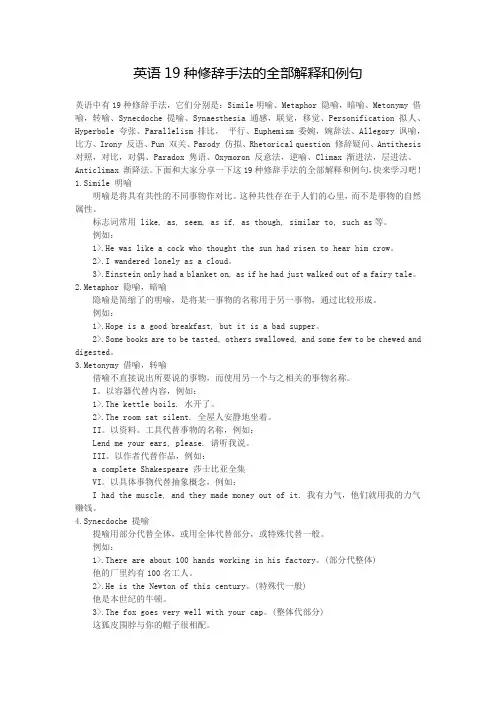
英语19种修辞手法的全部解释和例句英语中有19种修辞手法,它们分别是:Simile明喻、Metaphor 隐喻,暗喻、Metonymy 借喻,转喻、Synecdoche 提喻、Synaesthesia 通感,联觉,移觉、Personification 拟人、Hyperbole 夸张、Parallelism 排比,平行、Euphemism 委婉,婉辞法、Allegory 讽喻,比方、Irony 反语、Pun 双关、Parody 仿拟、Rhetorical question 修辞疑问、Antithesis 对照,对比,对偶、Paradox 隽语、Oxymoron 反意法,逆喻、Climax 渐进法,层进法、Anticlimax 渐降法。
下面和大家分享一下这19种修辞手法的全部解释和例句,快来学习吧!1.Simile 明喻明喻是将具有共性的不同事物作对比。
这种共性存在于人们的心里,而不是事物的自然属性。
标志词常用 like, as, seem, as if, as though, similar to, such as等。
例如:1>.He was like a cock who thought the sun had risen to hear him crow。
2>.I wandered lonely as a cloud。
3>.Einstein only had a blanket on, as if he had just walked out of a fairy tale。
2.Metaphor 隐喻,暗喻隐喻是简缩了的明喻,是将某一事物的名称用于另一事物,通过比较形成。
例如:1>.Hope is a good breakfast, but it is a bad supper。
2>.Some books are to be tasted, others swallowed, and some few to be chewed and digested。
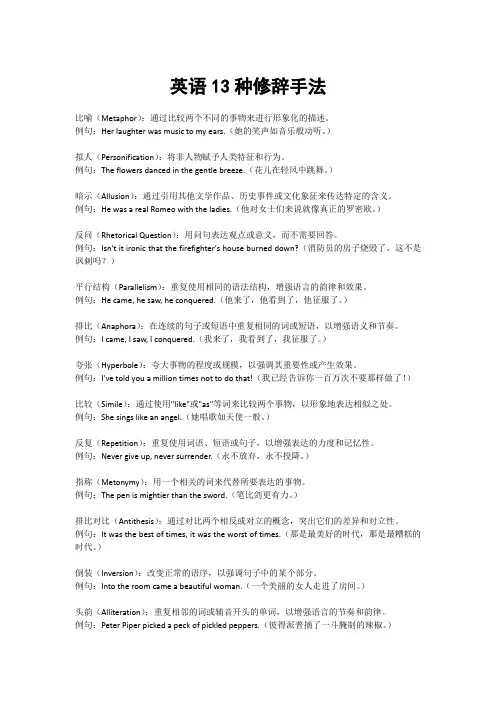
英语13种修辞手法比喻(Metaphor):通过比较两个不同的事物来进行形象化的描述。
例句:Her laughter was music to my ears.(她的笑声如音乐般动听。
)拟人(Personification):将非人物赋予人类特征和行为。
例句:The flowers danced in the gentle breeze.(花儿在轻风中跳舞。
)暗示(Allusion):通过引用其他文学作品、历史事件或文化象征来传达特定的含义。
例句:He was a real Romeo with the ladies.(他对女士们来说就像真正的罗密欧。
)反问(Rhetorical Question):用问句表达观点或意义,而不需要回答。
例句:Isn't it ironic that the firefighter's house burned down?(消防员的房子烧毁了,这不是讽刺吗?)平行结构(Parallelism):重复使用相同的语法结构,增强语言的韵律和效果。
例句:He came, he saw, he conquered.(他来了,他看到了,他征服了。
)排比(Anaphora):在连续的句子或短语中重复相同的词或短语,以增强语义和节奏。
例句:I came, I saw, I conquered.(我来了,我看到了,我征服了。
)夸张(Hyperbole):夸大事物的程度或规模,以强调其重要性或产生效果。
例句:I've told you a million times not to do that!(我已经告诉你一百万次不要那样做了!)比较(Simile):通过使用"like"或"as"等词来比较两个事物,以形象地表达相似之处。
例句:She sings like an angel.(她唱歌如天使一般。
)反复(Repetition):重复使用词语、短语或句子,以增强表达的力度和记忆性。
英语19种修辞手法的全部解释和例句英语中有19种修辞手法,它们分别是:Simile明喻、Metaphor 隐喻,暗喻、Metonymy 借喻,转喻、Synecdoche 提喻、Synaesthesia 通感,联觉,移觉、Personification 拟人、Hyperbole 夸张、Parallelism 排比,平行、Euphemism 委婉,婉辞法、Allegory 讽喻,比方、Irony 反语、Pun 双关、Parody 仿拟、Rhetorical question 修辞疑问、Antithesis 对照,对比,对偶、Paradox 隽语、Oxymoron 反意法,逆喻、Climax 渐进法,层进法、Anticlimax 渐降法。
下面和大家分享一下这19种修辞手法的全部解释和例句,快来学习吧!1.Simile 明喻明喻是将具有共性的不同事物作对比。
这种共性存在于人们的心里,而不是事物的自然属性。
标志词常用 like, as, seem, as if, as though, similar to, such as 等。
例如:1>.He was like a cock who thought the sun had risen to hear him crow。
2>.I wandered lonely as a cloud。
3>.Einstein only had a blanket on, as if he had just walked out ofa fairy tale。
2.Metaphor 隐喻,暗喻隐喻是简缩了的明喻,是将某一事物的名称用于另一事物,通过比较形成。
例如:1>.Hope is a good breakfast, but it is a bad supper。
2>.Some books are to be tasted, others swallowed, and some few to be chewed and digested。
英文中的修辞手法英文中有许多修辞手法,这些手法通过运用特定的语言技巧,可以增强文学作品的表达力和感染力。
以下是一些常见的英文修辞手法:比喻(Metaphor):将两个不同的事物进行比较,以强调它们之间的相似之处,而不使用"like"或"as"。
例如:“时间是一把无情的剑。
”拟人(Personification):赋予非人物以人的特质或行为,使其更具生动性。
例如:“风儿轻轻地低语。
”象征(Symbolism):使用一个事物、符号或象征来代表另一个抽象概念。
例如:“燕子在文学中通常象征着春天和希望。
”暗喻(Metonymy):用一个与所指实体有着密切关联的词汇来替代它。
例如:“白宫发布了一份声明”中的“白宫”代表美国政府。
排比(Parallelism):通过使用相似的句式或结构,强调语言的平衡和韵律。
例如:“我不怕困难,我不怕失败,我不怕挑战。
”双关语(Pun):利用一个词汇项的多义性或相似的发音来制造幽默或引起思考。
例如:“时间飞逝,果然很‘秒’。
”讽刺(Irony):通过言辞上的反讽,表达与字面意义相反的意思。
例如:“这个‘伟大’的计划居然失败了。
”悬念(Suspense):通过保持某种信息的不明确,刺激读者的兴趣,以激发紧张感。
例如:“她打开门,里面的一切都让她惊呆了。
”对仗(Antithesis):将相对或对立的思想或概念通过并列的结构进行强调。
例如:“昨夜寒风凛冽,今朝暖阳明媚。
”比较(Simile):将两个事物通过使用"like"或"as"进行比较,以突显它们之间的相似之处。
例如:“她如同一朵盛开的花。
”这些修辞手法可以单独使用,也可以结合在一起,创造出更为复杂和富有表现力的文学效果。
作家通常根据他们的写作目的,选择最适合表达自己意图的修辞手法。
英语的修辞手法英语的修辞手法有很多种,其中一些常见的修辞手法包括:1. 比喻(Metaphor): 指的是用一个事物来比喻另一个事物,从而使语言更加生动、形象。
例如,"She is a lioness in the office." (她是一只办公室中的母狮子。
)2. 拟人(Personification): 指的是将事物或概念拟人化,从而使语言更加生动、形象。
例如,"The mountains were dressed in white and the sky wept tears." (群山披上白色,天空流下泪水。
)3. 排比(Parallelism): 指的是用相似的结构来表达三个或以上的事物,从而使语言更加有力、优美。
例如,"To fish, to hunt, to plant, to harvest, to eat." (钓鱼,打猎,种植,收获,食用。
)4. 夸张(Hyperbole): 指的是用夸张的手法来表达一个事物或概念,从而使语言更加生动、形象。
例如,"She is as fast as lightning." (她快如闪电。
)5. 反问(Rhetorical Question): 指的是用问题的形式来表达一个观点或情感,从而增强语言的力量。
例如,"Isn't life beautiful, floating on the waves of life?" (生活难道不美好吗?在生命的波浪上漂浮。
)6. 讽刺(Satire): 指的是用讽刺的手法来表达对某人或某事的不满或轻蔑,从而引起读者的共鸣。
例如,"The CEO is such a genius that he can even solve the problems of his own company." (CEO如此天才,甚至能解决自己公司的问题。
20种常见英文修辞手法在写作时,含有修辞手法的句子和一句朴实无华的句子给批卷人的印象是截然不同的。
今天小编为大家介绍20中常见的英文修辞手法,任你挑选,喜欢哪种用哪种~ Simile明喻明喻是将具有共性的不同事物作对比,这种共性存在于人们的心里,而不是事物的自然属性。
标志词常用:like, as, seem, as if, as though, similar to, such as 等。
例如:1. I wandered lonely as a stray dog.我像一只流浪狗一样孤独地四处漂泊。
2. Einstein likes to put a cloak on, as if he had just walked out of a fairy tale.爱因斯坦喜欢披着斗篷,就好像刚刚从童话故事中走出来。
metaphor隐喻,暗喻隐喻是简缩了的明喻,是将某一事物的名称用于另一事物,通过比较形成。
例如:1. Hope is a good breakfast, but it is a bad supper.希望是顿美好的早餐,但却是一顿糟糕的晚餐。
2. Some books are to be tasted, others swallowed, and some few to be chewed and digested.一些书需要被“浅尝辄止”地阅读,另一些需要被“狼吞虎咽”般地阅读;很少一部分需要被“细嚼慢咽”地阅读。
metonymy借喻,转喻借喻不直接说出所要说的事物,而使用另一个与之相关的事物名称。
1. 以容器代替内容,例如:1)The kettle boils.水开了。
2)The room sat silent.全屋人安静地坐着。
2. 以资料、工具代替事物的名称,例如:Lend me your ears, please.请听我说。
3. 以作者代替作品,例如:a complete Shakespeare莎士比亚全集4. 以具体事物代替抽象概念,例如:I had the muscle, and they made money out of it.我有力气,他们就用我的力气赚钱。
英语中所有19种修辞手法的全部解释和例句拟声onomatopoeia,头韵alliteration,半韵assonance,移就transferred epithet,圆周句periodic sentences,反复repetition,倒装inversion,延喻 extended metaphor,共轭zeugma,嘲讽 ridicule 典故allusion1.Simile 明喻明喻是将具有共性的不同事物作对比.这种共性存在于人们的心里,而不是事物的自然属性.标志词常用 like, as, seem, as if, as though, similar to, such as等.例如:1>.He was like a cock who thought the sun had risen to hear him crow.2>.I wandered lonely as a cloud.3>.Einstein only had a blanket on, as if he had just walked out of a fairy tale.2.Metaphor 隐喻,暗喻隐喻是简缩了的明喻,是将某一事物的名称用于另一事物,通过比较形成.例如:1>.Hope is a good breakfast, but it is a bad supper.2>.Some books are to be tasted, others swallowed, and some few to be chewed and digested.3.Metonymy 借喻,转喻[mɪ'tɒnɪmɪ]借喻不直接说出所要说的事物,而使用另一个与之相关的事物名称.I.以容器代替内容,例如:1>.The kettle boils. 水开了.2>.The room sat silent. 全屋人安静地坐着.II.以资料.工具代替事物的名称,例如:Lend me your ears, please. 请听我说.III.以作者代替作品,例如:a complete Shakespeare 莎士比亚全集VI.以具体事物代替抽象概念,例如:I had the muscle, and they made money out of it. 我有力气,他们就用我的力气赚钱.4.Synecdoche 提喻[sɪ'nekdəkɪ]提喻用部分代替全体,或用全体代替部分,或特殊代替一般.例如:1>.There are about 100 hands working in his factory.(部分代整体)他的厂里约有100名工人.2>.He is the Newton of this century.(特殊代一般)他是本世纪的牛顿.3>.The fox goes very well with your cap.(整体代部分)这狐皮围脖与你的帽子很相配.5.Synaesthesia 通感,联觉,移觉[,sɪnɪs'θiːzɪə]这种修辞法是以视.听.触.嗅.味等感觉直接描写事物.通感就是把不同感官的感觉沟通起来,借联想引起感觉转移,“以感觉写感觉”。
以下是英语中常见的30种修辞手法:Alliteration(头韵): 一组词以相同的辅音音素开头。
Assonance(音韵): 一组词以相似的元音音素结尾或出现在词中。
Consonance(谐音): 一组词以相似的辅音音素结尾或出现在词中。
Simile(明喻): 使用"like"或"as"来进行比较,以明确两个不同的事物之间的相似之处。
Metaphor(隐喻): 通过将一个事物或概念直接应用于另一个事物或概念来进行比喻。
Personification(拟人): 赋予非人类事物或抽象概念人类的特征和行为。
Hyperbole(夸张法): 通过夸大和放大来强调一个观点或形容事物。
Understatement(轻描淡写法): 通过故意低估事物的重要性或程度来强调其效果。
Irony(讽刺): 通过语言表达与实际意义相反或冲突的观点。
Paradox(矛盾): 使用自相矛盾的语句来引起读者的思考和注意。
Oxymoron(矛盾修辞法): 将两个相反的词或短语并列使用,形成矛盾的修辞效果。
Euphemism(委婉语): 使用较为委婉的措辞来替代直接或冒犯性的表达。
Repetition(重复): 在文章或诗歌中重复使用相同的词语或短语来强调观点。
Parallelism(排比): 使用类似的语法结构或句式来强调一组观点。
Antithesis(对偶): 在句子或短语中对立地表达两个相反的观点或概念。
Climax(递进): 通过递进的方式将观点或事件按照重要性或程度进行排列。
Juxtaposition(并列): 将两个不同的事物或观点放置在一起,以产生对比或突出效果。
Anaphora(回文): 在连续的句子或短语中重复使用相同的词语或短语。
Epiphora(尾韵): 在句子或短语的结尾重复使用相同的词语或短语。
Allusion(典故): 引用文学、历史或文化中的人物、事件或作品来传达观点或增加文采。
英文修辞手法介绍
英文修辞手法介绍
1. 平行(Parallelism)
在句子结构中使用相同的语法结构,重复使用相同的词语,以及使用短语或从句来表达相似的想法。
例如:"I would rather be a meteor, something, every, every which way, all the way, bright, across the sky, every day, than just a grain of sand, lying there, shining for one day."
2. 反复(Repetition)
通过重复某些词语或短语来强调某个想法或情感。
例如:
"I am not a princess, I am not a slave, I am not a victim, and
I am not a quitter."
3. 押韵(Rhyme)
在词语的末尾使用相似的音韵来组织它们。
例如:
"Round and round, and round and round, we go together, in the circle of life."
4. 头韵(Alliteration)
在词语的开头使用相似的音韵来组织它们。
例如:
"All that glitters is not gold."
5. 隐喻(Metaphor)
使用一个比较或类比来说明一个抽象概念或想法。
例如:
"He is a lion in battle."
6. 明喻(Simile)
使用像“像”或“如同”这样的词语来比较两个不同的事物或概念。
例如:
"She sings like a bird."
7. 反问(Rhetorical question)
使用一个问题来表达一个陈述或观点,而不是提出真正的问题。
例如:
"Who needs help when you can help yourself?"
8. 夸张(Hyperbole)
使用夸大的语言来强调某个观点或情感。
例如:
"I am so tired, I could sleep for a whole day."
9. 矛盾修饰法(Oxymoron)
将两个相反的概念或情感结合在一起,以产生一种有趣的效果。
例如:
"That movie was an artistic masterpiece of sorts."
10. 仿词(Parody)
模仿一个已知的词语或短语,以产生一种幽默或讽刺的效果。
例如:
"He has the social skills of a rabid weasel."
11. 提喻(Synecdoche)
使用部分代替整体,或使用特定部分代替整个类别。
例如:
"Everybody eats the apple, not just the core."
12. 曲言(Euphemism)
使用一种礼貌或委婉的方式来表达不愉快的真相。
例如:
"He is resting in peace in the arms of God."
13. 借代(Metonymy)
使用一个相关的事物来代替一个更常见或更直接的事物。
例如:
"The pen is mightier than the sword."
14. 对仗(Antithesis)
在两个相对的概念或想法之间建立一种平衡或对比。
例如:
"To be or not to be, that is the question."
15. 拟人(Personification)
将非人类的事物赋予人类的特征或行为。
例如:
"The night whispered to me in the winds."
16. 倒装(Anadiplosis)
通过重复最后一个单词来组织句子。
例如:
"Round and round, and round and round, we go together, in the circle of life."
17. 讽刺(Irony)
使用一种明显与实际情况相反的语言来表达一种讽刺或幽默。
例如:
"He is such a nice person that he would never win the Nobel Prize for meanness."
18. 隽语(Paradox)
使用两个相反或矛盾的观点来表达一种看似矛盾,实则真实的陈述。
例如:
"The more you learn, the more you realize how little you know."
19. 排比(Parallelism)在句子结构中使用相同的语法结构,重复使用相同的词语,以及使用短语或从句来表达相似的想法。
例如:"I would rather be a meteor, something, every, every which way, all the way, bright, across the sky, every day, than just a grain of sand, lying there, shining for one day." 20. 倒装(Anadiplosis)通过重复最后一个单词来组织句子。
例如:"Round and round, and round and round, we go together, in the circle of life."。